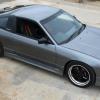Rb25 Turbo Upgrade, All Dyno Results
Announcements
-
Similar Content
-
Latest Posts
-
By Dose Pipe Sutututu · Posted
btw... here's a fun quote I got back in the day (using a NEO head and going shimless): a bit different initial requirement -
By Dose Pipe Sutututu · Posted
You can definitely do 450kW on the RB25 non-NEO head, plenty have. The $600 to $800 conversion will end up costing you much more I suspect, I believe you will require machining. NEO head has the lowest barrier to entry. My 2c? buy a BMW 😆 -
By Dose Pipe Sutututu · Posted
No more 90s JDMs for me, just want 4 door cars that won't attract cops. Wouldn't mind a Hako or a 240Z all motor but modernised (big comp, big cams, ABS, DBW, dis dat). -
The reason I made this thread was to try to get some useful info as all of the older threads only have tidbits here and there, while I do appreciate banter and suggestions of shoe horning V8s into cars, for the sake of someone trying to make a decision on this topic - is the general consensus that you really don't need to convert to solid lifters unless you're chasing wild above average power and rpms? options - Stick with hydro lifters possibly make 450kw at 7500rpms assuming all the right supporting mods for that goal Spend the $600-800 for the Solid lifters and find out how hard it is to set the clearances and what else needs replacing around them Neo head - possibly will cost more depending on the head prices at the time Throw away RB or buy a BMW 😆 There's a lot of the solid kits getting around from different manufacturers so someone must be doing the conversion
-








Recommended Posts
Create an account or sign in to comment
You need to be a member in order to leave a comment
Create an account
Sign up for a new account in our community. It's easy!
Register a new accountSign in
Already have an account? Sign in here.
Sign In Now